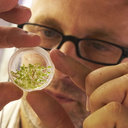HRE1 and HRE2, two hypoxia-inducible ethylene response factors, affect anaerobic responses in Arabidopsis thaliana.
Atslēgvārdi
Abstrakts
Plants often experience challenging hypoxic conditions imposed by soil waterlogging or complete flooding. In rice, Sub1A, a flooding-induced ethylene responsive factor (ERF) plays a crucial role in submergence tolerance. In this study, we examined two Arabidopsis Hypoxia Responsive ERF genes (HRE1 and HRE2), belonging to the same ERF group as Sub1A. Transgenic Arabidopsis plants, which over-expressed HRE1, showed an improved tolerance of anoxia, whereas a double-knockout mutant hre1hre2 was more susceptible than the wild type. HRE1 over-expressing plants showed an increased activity in the fermentative enzymes pyruvate decarboxylase and alcohol dehydrogenase together with increased ethanol production under hypoxia, but not in normoxia. Whole-genome microarray analyses suggested that an over-expression of HRE1, but not HRE2, increased the induction of most anaerobic genes under hypoxia. Real-time quantitative (q)PCR analyses confirmed a positive effect of HRE1 over-expression on several anaerobic genes, whereas the double-knockout mutant hre1hre2 showed a decreased expression in the same genes after 4 h of hypoxia. Single-knockout mutants did not show significant differences from the wild type. We found that the regulation of HRE1 and HRE2 by low oxygen relies on different mechanisms, since HRE1 requires protein synthesis to be induced while HRE2 does not. HRE2 is likely to be regulated post-transcriptionally by mRNA stabilization. We propose that HRE1 and HRE2 play a partially redundant role in low oxygen signalling in Arabidopsis thaliana, thus improving the tolerance of the plant to the stress by enhancing anaerobic gene expression and ethanolic fermentation.


